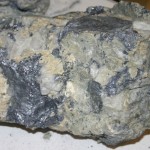

 Molybdenum rock beneficiation flotation method is mainly recovered in the molybdenum mineral is molybdenite. Sometimes in order to improve the quality of molybdenum concentrates, to remove impurities, to further chemical processing molybdenum concentrate outside the grounds. Molybdenite crystal structure of hexagonal layered or plate by Fan and health along the layer S-Mo-S structure and the layer of polar covalent bond formation of S-Mo. Layers and weak bonding between layers, and layer covalent bonding even stronger. Therefrock, the structure of molybdenite layer solution can easily split along the flaky or tabular output, which is the natural floatability chalcocite good reason.
Molybdenum rock beneficiation flotation method is mainly recovered in the molybdenum mineral is molybdenite. Sometimes in order to improve the quality of molybdenum concentrates, to remove impurities, to further chemical processing molybdenum concentrate outside the grounds. Molybdenite crystal structure of hexagonal layered or plate by Fan and health along the layer S-Mo-S structure and the layer of polar covalent bond formation of S-Mo. Layers and weak bonding between layers, and layer covalent bonding even stronger. Therefrock, the structure of molybdenite layer solution can easily split along the flaky or tabular output, which is the natural floatability chalcocite good reason.
Practice has proved that: at the right under the grinding fineness, the dissociation of molybdenite crystals occurs in S-Mo-S layer, the S-Mo surface hydrophilic small proportion. But after grinding time, S-Mo surface ratio of increase in the floatability of decline, although at this time adding a certain amount of polarity, such as xanthate collector class is beneficial to the recovery of molybdenite, but after grinding with the new sludge floatation effect. Therefrock, the sorting of molybdenite to avoid and prevent excessive wear in the production and the need to adopt multi-stage grinding sub-sorting process, step by step to monomer dissociation, to ensure a high recovery of molybdenum concentrate.
Molybdenum mining and processing techniques have been improved continuously since the first mine was started at Climax near Leadville, Colorado in 1916.Today, the principal moly mines, both primary and by-product, are found along the Great Continental Divide of the Americas, in China and in the CIS. Many of these mines are amongst the most productive in the world, with the largest capable of moving over 50,000 tonnes of rock per day.
Mining and processing plants are operated with minimum emissions under stringent environmental protection regulations.